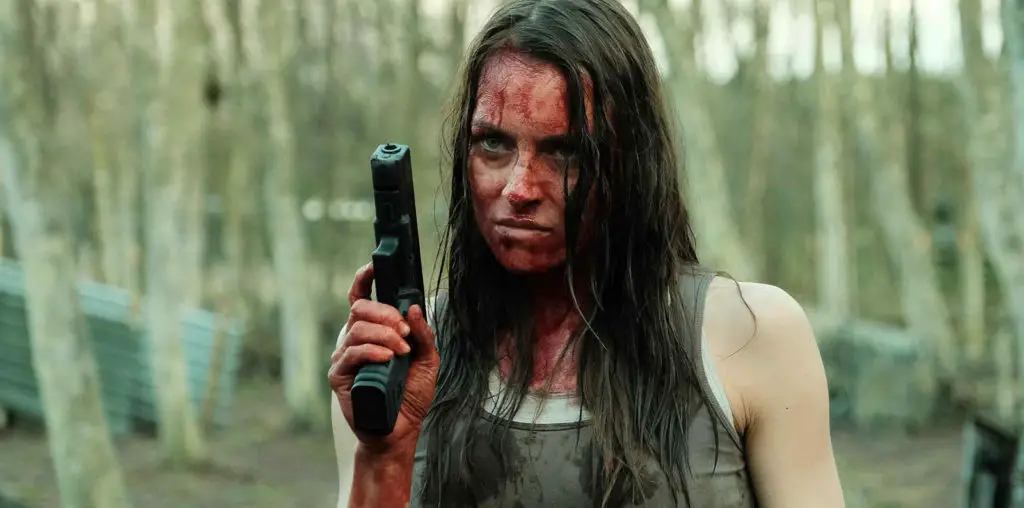
BOOTLEG FILES 208: “Dance Hall Racket” (1953 no-budget drama starring and written by Lenny Bruce).
LAST SEEN: We are unable to confirm the film’s last public screening.
AMERICAN HOME VIDEO: Only on labels specializing in public domain dupes.
REASON FOR BOOTLEG STATUS: An orphan film with a famous star and a lousy reputation.
CHANCES OF SEEING A DVD RELEASE: It is highly unlikely this film will ever be properly restored for a commercial DVD release.
During the peak years of his career, Lenny Bruce was such a hot potato that no Hollywood studio dared to consider him for on-screen film work. But that’s not to say Bruce didn’t dream of movie stardom. Alas, his sole effort to gain a foothold as a movie star has been widely maligned as being one of the worst films of the 1950s: “Dance Hall Racket,” which Bruce also wrote.
However flawed it may be, “Dance Hall Racket” is hardly a failure. The film is actually rather interesting, particularly since Bruce’s screenplay suggested a raw talent closer to Robert Altman’s ensemble storytelling style than the hard-boiled gangster flicks that inspired its contents. If you carefully dissect “Dance Hall Racket,” it appears that Bruce was a serious dramatic talent who could’ve blossomed with proper guidance and support.
On the surface, “Dance Hall Racket’ is a simple story: a sleazy dance hall is used as the cover for a gem smuggling operation. An undercover government agent infiltrates the setting, but in-fighting among the various parties within the operation helps to speed its downfall.
But “Dance Hall Racket” goes far beyond that setting into a deeper tapestry of off-beat personalities who populate the dance hall. Umberto Scalli, the suave owner of the establishment, runs a tight ship and doesn’t think twice about dispatching his goons Icepick and Vinnie to maintain order. Within the dance hall, a variety of young girls express rue and indifference to their less-than-glamorous jobs of entertaining a variety of bums, dreamers and losers. An older dance hall employee serves as a mother hen to the girls, giving them encouragement to make the best of their dubious employment. Around the dance hall’s bar are a variety of inebriates and sad souls drowning their disappointments in booze and broads. One man is determined to save up enough dance tickets so he can have full run of the establishment for one night, where he would be able to keep other patrons out and have the girls to himself. Another man, a drunken Swede, goes through elaborate lengths to steal drinks from unsuspecting patrons and the agitated bartender.
Bruce is often considered as the star of the film, but in truth “Dance Hall Racket” has no single star to fuel it. In fact, Bruce (playing the goon Vinnie) actually has a small role – Timothy Farrell, as Umberto Scalli, has more screen time. In true Altmanesque fashion, all of the characters in the film intersect at various points in the film – stories overlap in a variety of plot avenues that all end in a single event – in this case, a disastrous party – that brings the action to a sharp close.
Watching “Dance Hall Racket” today, it is a major shame that Bruce’s screenplay wasn’t provided to a better production outfit. Exploitation producer George Weiss kept the film in an ultra-low budget setting (it looks as if it was shot in someone’s basement) while hack director Phil Tucker, best known for the egregious “Robot Monster,” had no clue how to frame a shot. Weiss and Tucker created a film that looks like a piece of s**t. It could’ve been a fine little movie with the right people behind the cameras. As it stands, it deserves a second look only because of its cast.
Of course, there’s Lenny Bruce. Admittedly, he is miscast as the too-tough Vinnie. Can you imagine Lenny Bruce as a switchblade-swinging, karate-chopping nutjob who is pathologically jealous of his girlfriend? Even if he was the wrong man for the part, it is impossible not to admire Bruce’s willingness to step outside of his comic persona and attempt to inhabit an unusual role. Even though he fails to reach the outer edges of Vinnie’s neuroses, Bruce is still a magnetic presence – your eyes stay on him, no matter who else is on screen.
Also present is Bruce’s mother, Sally Marr, who was a veteran burlesque performer who never achieved mainstream success. This wasn’t due to a lack of charm and beauty (she was quite attractive in this film) or talent (she performs a comic Charleston which is the highlight of the movie). Marr’s lack of stardom was just one of those bad breaks – hey, it happens.
There is also Bruce’s wife, Honey Harlow. Her talent was conspicuously limited, but she was a gorgeous woman with a kooky sense of on-screen irony. With the right acting classes, it is easy to imagine she could’ve achieved stardom in her own right.
Plus, the film includes the much-underrated Timothy Farrell. He was a staple of low-budget flicks in the 1940s and 1950s, including a pair of Ed Wood movies. But he was hardly a bad actor. Indeed, he had an uncommon sense of self-assurance that few Grade Z film stars possessed. As with Sally Marr, he never snagged a good career break – his one Grade A credit was the Judy Garland version of “A Star is Born,” in which he had an uncredited bit part as a bailiff.
Finally, there is a wonderful clown in the film named Bernie Jones. He played the Swedish drunk and he was quite amusing in that small, lowbrow part. Jones was a member of Spike Jones’ wacky comedy troupe and never became famous as a solo artist. “Dance Hall Racket” was among the few times he actually managed to get some time for himself on screen.
“Dance Hall Racket’ was barely seen in 1953. A minor distributor named Screen Classics dumped it in the grindhouse circuit, where it sank without a trace. The film lapsed into the public domain and it has been bootlegged over the years. Scratchy prints several generations from the original source material appear to be all that remains.
Lenny Bruce tried a few more times to made headway into movies. He wrote a burlesque comedy called “Dream Follies.” Sally Marr starred in that and Bruce had an unbilled bit part; unfortunately, Phil Tucker also directed that. He then collaborated on the screenplay of an obscure sci-fi comedy called “The Rocket Man” that was released by 20th Century Fox; he was not asked to be in the cast. Bruce also tried to get financing on something called “The Leather Jacket,” in which he hoped to star, but the film was aborted after shooting test footage. Outside of being the subject of a 1967 filmed record of his stage act, Bruce never found his niche in movies.
That leaves us with “Dance Hall Racket,” which is obviously not representative of Lenny Bruce’s brilliance. But the film is also not deserving of its obscurity and poor reputation. If anything, it provides a sad sense of “what if” surrounding its volatile creator – with the right backing and nurturing of this project, his career could’ve gone into a very different direction.
IMPORTANT NOTICE: The unauthorized duplication and distribution of copyright-protected material is not widely appreciated by the entertainment industry, and on occasion law enforcement personnel help boost their arrest quotas by collaring cheery cinephiles engaged in such activities. So if you are going to copy and sell bootleg videos, a word to the wise: don’t get caught. The purchase and ownership of bootleg videos, however, is perfectly legal and we think that’s just peachy! This column was brought to you by Phil Hall, a contributing editor at Film Threat and the man who knows where to get the good stuff…on video, that is.
Discuss The Bootleg Files in Back Talk>>>


You were waaaaay too kind to this movie (which is available for free onYouTube). Just horrible. I was also riveted by Lenny—although his portrayal of a tough guy was about as convincing as mud. And Honey was surprising competent in her little part. With that said—it was painful.